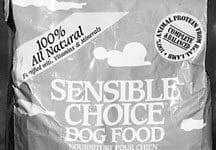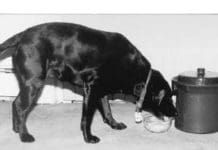Hidden Killers in Dog Food
I own a beautiful German Shepherd named Xeus. He comes from very well-known, healthy, wonderful lines. Xeus is sound, has personality galore and a wonderful temperament – he’s just an all-around great German Shepherd. One Saturday in late June 1999, a really nice, hot summer day, my entire family was hanging out in our back yard, enjoying our pool, as we watched Xeus enjoy his kiddie pool. All of a sudden, Xeus jumped out of his wading pool and made a bee-line for the house. I watched him go in, thinking he was just looking for another toy to bring out, but he didn’t come back out.
When Feeding a Raw Diet Use Safe Meat Handling Practices
One of the greatest concerns many people have about switching their dogs to a raw diet is the fear of bacterial infection, either in themselves or their pets. News reports of people dying from E. coli and salmonella poisoning have no doubt fanned the flames of that fear. But most people who have successfully transitioned their dogs to a raw diet report no problems are delighted with their dogs’ health and appearance. The secret, advocates say, is in good food handling practices. Dog owners who neglect safe handling techniques are certainly more at risk of infection from any pathogens (a list of the usual suspects is discussed in great detail in “What Evil Lurks Within,” page 9) that happen to be present in raw meat. This is especially true of children, whose immune systems are immature and inexperienced, and people with compromised immune systems. But keeping your meat safe and your kitchen clean is not exactly rocket science, folks! Anyone can learn to do it.
When it Comes to Dog Food – What Does the Term “Natural” Really Mean?
Maybe it’s partially our fault, but the word “natural” is getting a lot of exposure on dog food labels these days. The problem is, it doesn’t mean anything in particular; there is no official definition of the word. It just sounds good, and companies like Pet Products Plus, Inc., makers of Sensible Choice, like to use it a lot. A bright yellow banner on the front of the bag says, “100% All Natural.” And the back of the label explains, “Sensible Choice dog foods are all-natural products. . . In other words, if it’s not found in nature, you won’t find it in Sensible Choice.” But that just doesn’t explain something like “natural flavor,” the sixth ingredient listed on the label of the Sensible Choice Lamb and Rice food. Natural what flavor?
Can Meat Cause Kidney Failure?
CA 94501; or fax to (510) 749-4905
Choosing Canine Supplements Wisely
Sometimes, the deficiency is discovered when a blood test is performed for the purpose of analyzing the dog’s nutritional status (although, in my opinion, there are some problems with this methodology (see “Blood Testing for Deficiencies,” next page). In other cases, a dog owner might know that the diet he feeds is deficient in a certain nutrient, and he supplements rather than changes the formulation of the diet. For example, dogs who are fed a diet based on raw meats and vegetables, but who don’t receive fresh ground bones, are more than likely to be deficient in calcium.
Who’s in Charge of Pet Food Manufacturing Regulations?
While most dog owners are certain that “someone” is in charge of regulating the manufacture of commercial dog food in this country, very few people know who that mysterious official or agency might be. But somebody’s gotta be making sure that dog food doesn’t contain any harmful ingredients and does contain what dogs need to survive, right? The FDA? Department of Agriculture? Someone?
Does Your Dog Eat Grass?
radish sprouts
Frozen Raw Meat Diets for Dogs
About frozen raw meat diets for dogs: We’ve got some good news, and some bad news. Here’s the good news: raw meat-based diets are really “what’s best” for dogs. With their sharp, tearing teeth, jaws capable of crushing bones, and short, highly acidic digestive systems, dogs are made to eat and thrive on diets that are made mostly of meat and bones. Every holistic veterinarian we know suggests feeding a raw meat-based diet, both to improve a dog’s existing health, or to recover it. Vital amino acids and food enzymes, vital for superior digestion and nutrient absorption, are present in raw meat, and survive the freezing/defrosting process beautifully.
Raw-Fed Puppies
When dog lovers switch their pets from commercial food to a well-balanced, raw diet, they typically report improved health, brighter eyes, a shinier coat, calmer behavior, and easier yard cleanup chores. A puppy's first eight weeks set the stage for a lifetime of health or illness, so it isn't surprising that puppies weaned on raw food grow up to out-perform dogs weaned on kibble or canned food, even if both are fed raw food as adults. Raw-weaned puppies nearly exhaust their breeders' vocabularies, for these are the healthiest / strongest / liveliest / calmest / smartest / most wonderful pups that ever lived.
Canned Dog Food or Dry Dog Food? We’ll Help Break it Down
Caring guardians of companion canines often wonder whether one form of commercially prepared food – kibble or canned – is better than the other. The truth is, both types of food have relative advantages and disadvantages in terms of palatability, digestibility, and necessity for preservatives or other chemical additives. While they generally meet the same chemical composition standards in terms of vitamins, minerals, and amino acids, these types of food provide very different nutritional value.
It’s All In How You Make It
reduce pesticide residues by washing well
Nutrition for Dogs: Fat, Protein and Carb Levels in Dog Food
There are many kinds of proteins, which are made of complex, organic compounds. Each type of protein consists of a varying mix of amino acids attached to each other with peptide bonds. Dogs can manufacture some of the 22 amino acids found in their bodies, but need a dietary source for others. Amino acids build body proteins, which in turn function as components of enzymes, hormones, a variety of body secretions, and structural and protective tissues.

















